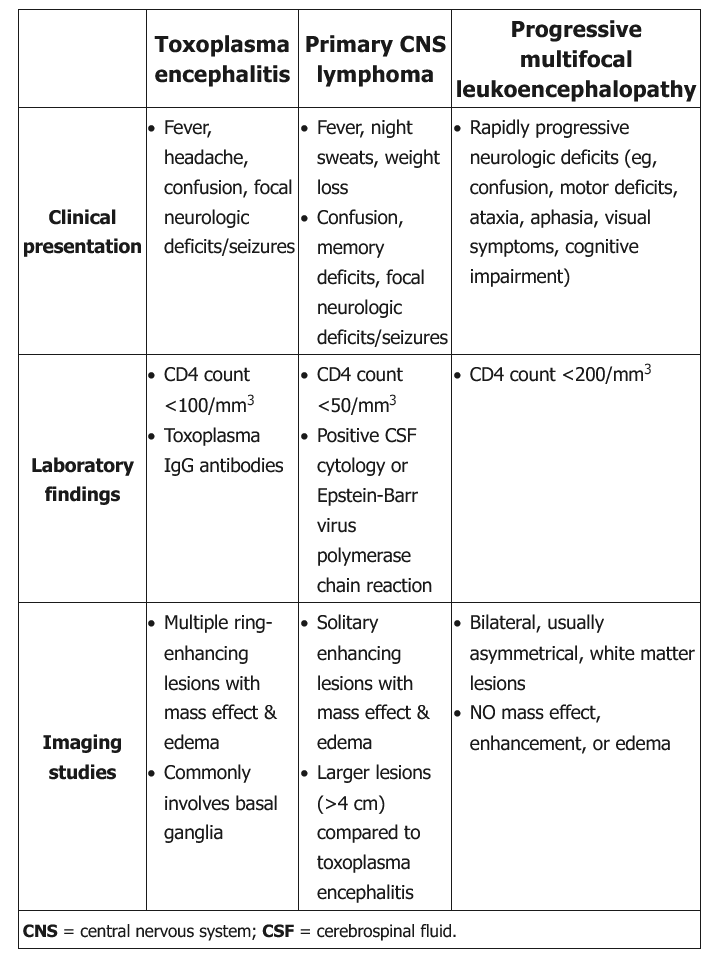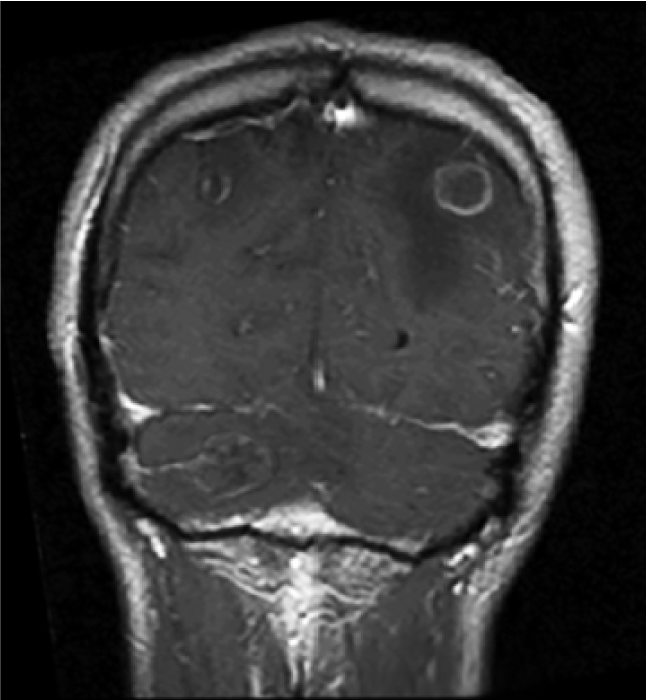HIV CNS lesions
- related: ID
- tags: #id

Toxoplasma gondii infection in AIDS usually presents in patients with CD4 cell counts less than 100/µL. Because it is a reactivation disease, patients are usually serology positive. Clinical presentation includes headache, fever, and focal neurologic deficits. Imaging by CT or MRI (which is more sensitive) reveals multiple ring-enhancing lesions. The differential diagnosis includes primary central nervous system lymphoma, which most often appears as a single lesion on imaging, and progressive multifocal leukoencephalopathy, which is usually nonenhancing. Diagnosis of central nervous system toxoplasmosis is usually presumptive based on presentation, imaging, and response to empiric treatment.
 CNS Toxoplasmosis.
CNS Toxoplasmosis.
This patient with subacute headache, neurologic symptoms, and a single ring-enhancing lesion at the grey-white matter junction most likely has a brain abscess. Single brain abscess usually results from direct extension from a dental, sinus, or ear infection; hematogenous dissemination from a distant infection tends to cause multiple abscesses but can occasionally lead to single abscess. This patient's intravenous drug use, holosystolic murmur, and Janeway lesions (erythematous macules on the palms) suggest that his single abscess may be due to underlying infectious endocarditis.
Brain abscess is usually the result of Streptococcus or Staphylococcus infection, but patients with HIV are susceptible to a wider range of bacterial (eg, Listeria, Nocardia), fungal (eg, Aspergillus, Cryptococcus), and parasitic (eg, Toxoplasma) organisms. Symptoms tend to be nonspecific and insidious and often include unilateral headache localized to the side of the lesion, focal neurologic deficits, seizures, or papilledema. Fever and leukocytosis are frequently absent, particularly in those with underlying immunosuppression. CT scan with and without contrast typically reveals single or multiple ring-enhancing lesions at the grey-white matter junction with significant vasogenic edema or mass effect. Treatment with antibiotics and surgical drainage is usually curative, but many patients are left with residual seizure disorder.
Patients with HIV can also develop lesions due to:
- Toxoplasmic encephalitis - typically causes multiple ring-enhancing lesions in the basal ganglia and frontal/parietal lobes and almost always occurs in patients with CD4 counts <100/mm3 (unlike this patient) who have positive toxoplasma IgG serology and are not on chemoprophylaxis.
- Primary central nervous system lymphoma - typically appears as a single, large (>4 cm), ring-enhancing lesion in the subcortical white matter and almost always occurs in patients with CD4 counts <50/mm3.
- Progressive multifocal leukoencephalopathy is a rapidly progressive demyelinating disorder due to JC virus reactivation that usually occurs in patients with CD4 counts <200/mm3. Brain imaging usually reveals multifocal areas of white matter demyelination with no mass effect, edema, or enhancement.
HIV-associated encephalopathy generally affects the whole brain and presents with progressive dementia. Patients tend to have brain atrophy without ring-enhancing lesions on imaging.